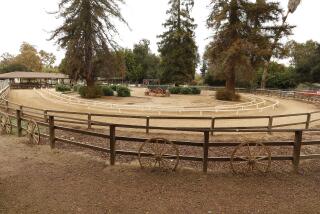Waste Not, Want Not
Los Angeles Zoo elephants Gita and Ruby are among the most generous contributors to the Griffith Park Composting Facility--the first compost plant in the country, according to city officials, to use zoo waste in conjunction with treated human waste and green trimmings.
The two elephants, who deposit about 700 pounds of compost ingredients a day, hammed it up Thursday for a crowd of politicians and reporters during the dedication of the plant, the first compost facility owned and operated by Los Angeles. The facility, at 5400 Griffith Park Drive about a mile north of the zoo, blends manure and other organic matter from the zoo with green waste and treated sludge from the city’s Hyperion Treatment Plant.
The composting program is a joint venture between the city’s Bureau of Sanitation, the Department of Recreation and Parks and the Los Angeles Zoo.
“That’s first-class teamwork,” said Tom LaBonge, special assistant to Mayor Richard Riordan. LaBonge said that he and other volunteers have used the special compost to spruce up part of Griffith Park.
By having its own composting facility, the city of Los Angeles is able to circumvent many of the costs associated with contracting out for such services, said Doug Walters, project engineer for the Department of Public Works.
Councilwoman Ruth Galanter called the facility “just the beginning of an environmental showcase. The city of Los Angeles does the best environmental work in the country, but no one knows about it.”
In development for more than six years, the plant started operating around 1996 on an experimental basis. “It was basically to see how it works, and to show how good a neighbor we could be,” said city public works engineer Reva Fabrikant. In the spring of 1997, the plant received a permit to operate on a long-term basis.
The composting process--which, among other things, suppresses odor--yields what city and zoo officials call Topgro, a fertilizer used at city parks and schools.
It also is being sold to independent contractor and ranch owner Slick Gardner, who was awarded an exclusive contract in January to sell the compost. He is trying to develop a market for the fertilizer as an exotic compost. Part of the profits will be funneled back to the Los Angeles Zoo, he said.
The city has yet to decide how much of the compost will be sold for profit and how much will be donated to schools and other community groups, Fabrikant said.
Walters said a major hurdle for this kind of facility is the natural revulsion that the public has for waste, particularly human waste. Often, he said, human waste--even treated--is associated with filth, disease and, of course, flies.
Three times a week, the plant mixes 15 tons of waste from Hyperion, four to eight tons of “zoo doo,” and 40 cubic yards of green clippings from Griffith Park to make compost. The U.S. Department of Agriculture approved the city’s plan to compost zoo manure in 1995, noting that they were “satisfied that [the city’s] composting proposal will take care of any infectious agents.”
One of the concepts behind the Griffith Park facility is “full-cycle recycling”--the notion that all sorts of waste can be used in a way that maximizes their regenerative qualities.
It was Galanter, officials said, who suggested using Gita and Ruby at Thursday’s news conference to get the message out.
Ultimately, Galanter said, “we’re helping to reduce the amount of stuff that is going into landfills.”



